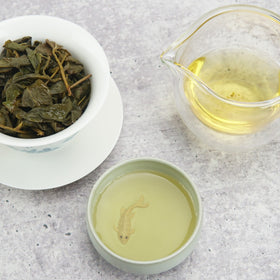Grandma's China
This is a small illustrated essay on the collection of my mother-in-law's bone china. She got them from her own mother and mother-in-law. She thinks they are at least about 50 years old. And no, she is not interested in selling them.
China and Porcelain
China is the soul of tea. It did not just give the world-embracing brew, but also the fine porcelain in which it was to be consumed. Who has not beholden an antique Chinese porcelain of stunning beauty.
The history of porcelain goes deep into Chinese antiquity. Generally, it is a ceramic material made by firing raw materials, including clay in the form of kaolin and petuntse, in a kiln to temperatures between 1,200 °C (2,192 °F) and 1,400 °C (2,552 °F). The toughness, strength, and translucence of porcelain arise mainly from the formation of glass and the mineral mullite within the fired body at these high temperatures.
The Chinese were already using delicate porcelain teapots and bowls in their tea drinking ceremonies,during the period Europe got introduced to tea. Later, merchants from the Continent imported these wares along with the loose tea leaves. As tea grew in popularity among the wealthy, so did the ritual of drinking tea from these porcelain cups services.
Because collecting Chinese tea services became rapidly popular, some entrepreneurs decided to craft and manufacture porcelain tea sets for sale in Europe. English potters started by copying some of the designs produced in China. The region of Staffordshire became an established area for pottery. Almost all the famous English manufacturers of Bone China were based here.
Invention of Bone China and the reign of English China
The most important advancement in porcelain making came from Josiah Spode in late 18th Century. He invented and perfected a process that added bone ash, flint and feldspar to the English clays. These additions produced the material known as bone china, which was the hardest, most durable porcelain available. Today, bone china is synonymous with fine English tea sets.
Bone ash comes from the pulverized and burned bones of animal. By adding bone ash to the porcelain also made the end product less expensive and lighter in weight. Because it was less expensive, it allowed more middle class families to purchase and enjoy porcelain tea sets, creating an unprecedented market for ceramics in England and Europe.
Colclough China Ltd (1937-48)
Colclough Bone China - Founded 1890 Staffordshire, England 1890 by Herbert J. Colclough. Ex-Mayor of Stoke-on-Trent, Herbert Colclough was a china lover, work-a-holic and man of the people. He was the man to bring fine bone china to ordinary people rather than the rich few.
His vision for his beloved china company was to get royal patronage which he succeeded in doing in 1913 when he was bestowed a royal license for ‘Royal Vale’ china by George 1V.
Colclough went on to innovate the production of fine bone china for the mass market in the 1930’s which makes Colclough an important part of antique bone china history.
They were the first company to produce fine bone china for the every day market which was marketed by the piece, ruling out the need for large sets to be purchased first.
In 1948, Colclough China Limited took over Booths and Adderley and then in the early 1950's merged with the Ridgeway Company.
Colclough and Ridgeway became part of the Royal Doulton Group in the early 1970's. However, in 1996, Colclough discontinued production.
Delphine, JH Middleton & Co. (1889-1941)
The company continues as Hudson and Middleton Ltd, their wares identified by HM Sutherland China.
Melba China Co Ltd (1948-51)
Operated out of Stafford St, Longton, Stoke-on-Trent
Royal Albert (1873-)
Was was established by Alferd Meakin in 1873. In 1904 the ‘Royal’ tag was bestowed due to the firms’ efforts in making commemorative ranges for Queen Victoria’s Diamond Jubilee.
Many early shapes were fluted, and included floral motifs and rich patterns in shades of red, green and blue in the style of popular Japanese Imari patterns. Above all, Royal Albert's early success was linked to an uncanny ability to cater for all tastes - from the modest to the most expensive. What’s more, the first Royal commemoratives were produced as early as 1897 to celebrate Queen Victoria's Diamond Jubilee.
The Royal Albert’s designers are credited with the development of distinctively English, globally popular, style. It was they who combined the fineness, whiteness and purity of the bone china ceramic body with sensual and informal rococo shapes and floral designs. The English fondness for cottage gardens and shady woods naturally inspired thousands of designs - motifs which have been adapted and updated through period fashions, such as 1920s vivid Art Deco floral patterns.
And the royal links have been retained. Royal Albert has two Royal Warrants and continues to commemorate important events and anniversaries. Most recently, in 2002, Royal Albert marked the Golden Jubilee of the accession of Queen Elizabeth II, and the death of HM Queen Elizabeth the Queen Mother with small collections.
Royal Adderley (1876-)
Founded in 1876 by William Alsager Adderley in Longton, Stoke-On-Trent, England. Also became known in the 1950's as 'Royal Adderley' under the 'Ridgway' backstamp. The firm was actually oficially known as "Adderleys Ltd" from 1906 until its takeover by Pearsons Ridgway in 1947 when the Adderley pottery mark was retained as a backstamp only.
The mark 'Royal Adderley' was also used after the 1947 merger, especially for bone china tea sets. The 'Royal' tag was transferred from the Ridgways warrant. John Ridgway had been appointed potter to Queen Victoria in the 1850's.
Tuscan, RH&SL Plant (1898-)
Like for the others, the company changed its emblem over the years, under different owners. The one here is from post-1947 but before take over by Wedgwood around 1972.
Staffordshire records show that the Plant family were potters of renown going back at least as far as 1775. There are jugs and white glaze baskets marked 1780 - made by a Benjamin Plant. Also, the 1775 diary of the same individual is kept in a private collection showing how much he paid for glazes and other potting materials - a unique insight into the history of Tuscan tableware.
Their branded bone-china was known as 'Tuscan' until 1967 after which they were taken over by new parent company, Wedgwood who added the ‘Royal’ prefix for marketing purposes.
Victoria (1828-1955)
Victoria Works was established in 1828 by Ralph Shaw. It was subsequently run by his tenants which included Yale and Barker. In this case, the various owners of the company over the years can be identified in this initials in the emblem.
This one here has CE, coming from the period 1912-55, when the Works was owned by Cartwright & Edwards.
In the19th century the firm produced most classes of earthenware and extended their range to bone china in the 20th century. The firm became a subsidiary of Alfred Clough Ltd. in 1955 and both the Victoria Pottery and the Borough Pottery were sold to the Manor Engineering Company.
Sources:
http://www.thepotteries.org/
http://www.figurines-sculpture.com/
http://www.mygrannysatticantiques.com/
http://en.wikipedia.org/wiki/
http://www.royalalbertpatterns.com/








